Magnetism and electricity: Identify, describe, and apply principles of electrostatics (static electricity)
Unit 2: Interaction of charge
Leigh Kleynhans
Unit outcomes
By the end of this unit you will be able to:
- Identify and predict the distribution of charge over the surface of a conductor (spherical and non-spherical).
- Identify and predict action between electric charges, the attraction between charged and uncharged objects and action of highly charged points.
- Identify and describe electrostatic induction.
What you should know
Before you start this unit, make sure you can:
- Identify the two types of charge.
- Describe how objects become charged, as covered in Subject outcome 4.2, Unit 1.
Introduction
In this unit[1] you will learn about the arrangement of charge on a conductor and an insulator, how charged and uncharged objects interact and the principle of electrostatic induction.
Charged particles or objects with an overall net charge exert forces on one another. The force exerted by non-moving (static) charges on each other is called the .
The electrostatic force
The basic rule of electrostatics is that like charges experience a and unlike charges experience an .
In other words, like charges repel each other while opposite charges attract each other.

Exercise 2.1
Two charged hollow metal spheres hang from strings and are free to move as shown in the picture below. The right hand sphere is positively charged. The charge on the left hand sphere is unknown.
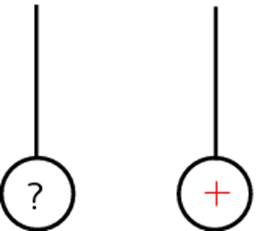
The left sphere is now brought close to the right sphere.
- If the left sphere swings towards the right hand sphere, what can you say about the charge on the left sphere and why?
- If the left sphere swings away from the right sphere, what can you say about the charge on the left sphere and why?
The full solutions are at the end of the unit.
Note
Watch this video of a static electricity science demonstration to see electrostatic forces in action (Duration: 1.45).
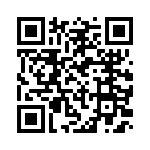
Charge distribution
Some materials allow electrons to move relatively freely through them (e.g. most metals, and the human body). These materials are called .
Other materials do not allow the charge carriers, the electrons, to move through them (e.g. plastic, and glass). The electrons are bound to the atoms in the material. These materials are called non-conductors or .
If an excess of charge is placed on an insulator, it will stay where it is put and there will be a concentration of charge in that area of the object. However, if an excess of charge is placed on a conductor, the electrons will repel each other and spread out over the outer surface of the object.
If the conductor has a spherical shape, the excess electrons will spread uniformly over the surface of the sphere. However, for conductors with irregular shapes, there is a concentration of charge near the point or points of the object.
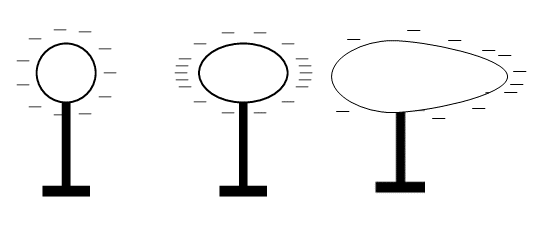
In non-spherical objects, the collection of charge where the object is narrower can allow charge to leak off the conductor if the point is sharp enough. It is for this reason that buildings often have a lightning rod on the roof to remove any charge the building has collected. This minimises the possibility of the building being struck by lightning.
This is also the reason why it is safe to be inside a car during a lightning storm. The excess charge in the lightning will spread out on the outer surface of the (metal) car and therefore the inside will be safe. This concept is called a .
This “spreading out” of charge would not occur if we were to place the charge on an insulator since charge cannot move in insulators.
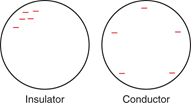
Interaction between charged and uncharged objects
Unlike conductors, the electrons in insulators (non-conductors) are bound to the atoms of the insulator and cannot move around freely through the material. However, a charged object can still exert a force on a neutral insulator due to a phenomenon called polarisation or .
If a positively charged rod (B in Figure 4 below) is brought close to a neutral insulator such as a polystyrene ball (A in Figure 4 below), it can attract the bound electrons to move round to the side of the atoms which is closest to the rod and cause the positive nuclei to move slightly to the opposite side of the atoms. This process is called polarisation. Although it is a very small (microscopic) effect, if there are many atoms and the polarised object is light (e.g. a small polystyrene ball), it can add up to enough force to cause the object to be attracted onto the charged rod. Remember, that the polystyrene is only polarised, not charged. The polystyrene ball is still neutral since no charge was added or removed from it. The picture shows a not-to-scale view of the polarised atoms in the polystyrene ball.
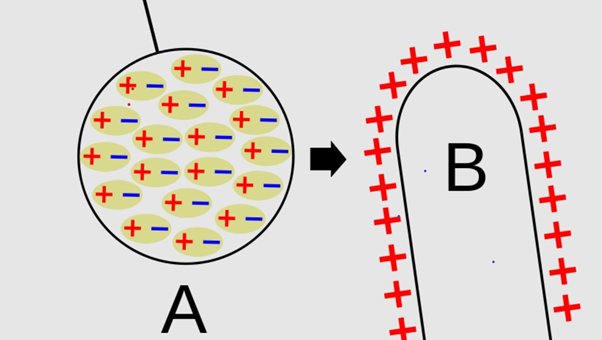
Some materials are made up of molecules that are already polarised. These are molecules that have a more positive and a more negative side but are still neutral overall. Just as a polarised polystyrene ball can be attracted to a charged rod, these materials are also affected if brought close to a charged object.
Activity 2.1: Polarising an aluminium can
Time required: 10 minutes
What you need:
- internet access
What to do:
- Open the link to the Physics Classroom.
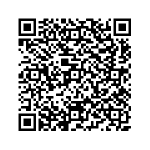
- Play with the simulation, moving the rods about the screen and observing the behaviour of charges within the can.
- Describe what must happen inside the aluminium can in order for it to be attracted to a positively charged and to a negatively charged object.
What did you find?
The neutral aluminium can becomes polarised when a positively charged or negatively charged rod is held near it. The polarisation causes the side of the can near the rod to have an opposite charge to the rod itself. The can and the rod then experience an attractive force.
Note
Watch this static electricity demonstration to consolidate your understanding of the interaction of charged objects and electrostatic induction (polarisation) (Duration: 10.34).
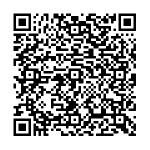
Summary
In this unit you have learnt the following:
- Charged objects exert electrostatic forces on each other.
- Like charges repel and unlike charges attract.
- Excess charge on a conductor that is spherical will distribute evenly around the outer surface.
- Excess charge on a conductor with an irregular shape will concentrate in the narrower areas forming highly charged points.
- Charged objects can interact with uncharged objects creating a force of attraction because of electrostatic induction or polarisation.
Unit 2: Assessment
Suggested time to complete: 15 minutes
- Complete the sentence: The electrostatic force between like charges is ________, while between unlike charges it is _______.
- Two positively charged metal balls are placed 20 cm apart.
- Explain what will happen.
- If the balls are now placed 10 cm apart, explain what will happen.
- A Perspex ruler is positively charged by rubbing it with a piece of cloth. It is then held over small pieces of paper.
- Describe what will happen.
- Give the term for this phenomenon.
- Explain the observation.
- Explain how a stream of water can be attracted to a charged rod.
- Spray painting makes use of electrostatic forces. Study the diagram below and explain how the process works in the painting of the fence.
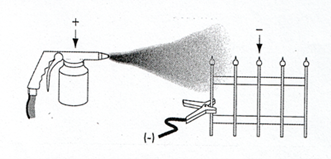
- Two identical light balls, A and B, are shown below. The diagram shows what happens when ball A is brought near ball B and held still. Which combination of charges on the balls would NOT produce the result shown?

Ball A Ball B A positive neutral B negative neutral C positive positive D negative positive - The diagram below represents a neutral can. The positive and negative signs are a simple representation of the spread of charge on the surface of the can.
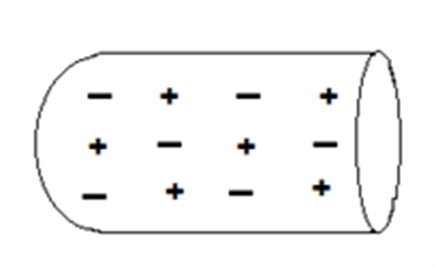
.
The can is placed next to a positively charged pith (lightweight) ball as shown below. This changes the position of some of the charges on the surface of the can due to polarisation.- Draw the resulting representation of the positive and negative charges on the surface of the can.
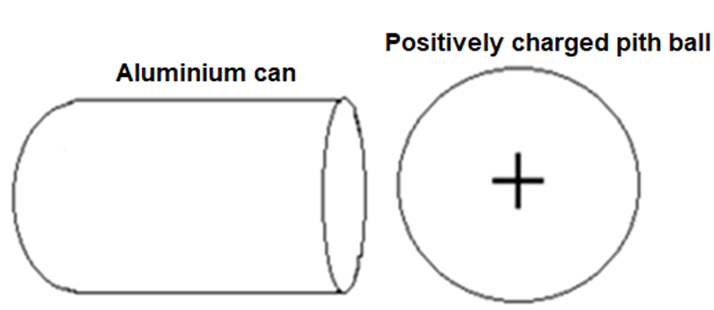
- Explain how they can become polarised.
- Draw the resulting representation of the positive and negative charges on the surface of the can.
The full solutions are at the end of the unit.
Unit 2: Solutions
Exercise 2.1
- The charge is negative. Unlike charges attract, so it needs to have an opposite charge to the right-hand sphere.
- The charge is positive. Like charges repel, so it needs to have the same charge as the right-hand sphere.
Unit 2: Assessment
- The electrostatic force between like charges is repulsive, while between unlike charges it is attractive.
- .
- They will repel each other because the electrostatic force between like charges is repulsive.
- They will repel each other with a stronger force because electrostatic forces increase when the distance between the charged objects decreases.
- .
- The pieces of paper will be attracted to the ruler.
- Polarisation or electrostatic induction.
- The positively charged ruler causes the electrons (negative charges) in the paper to move slightly towards the ruler, inducing a negative charge on the side of the paper nearest the ruler. As a result there is an attractive force because unlike charges attract.
- The molecules of water are polar (they have a positively charged side and a negatively charged side). If a charged rod is held near a stream of water, the oppositely charged side of the water molecules will be attracted towards the rod.
- The metal fence is connected to the negative terminal of a battery so that it becomes negatively charged. The spray gun is connected to the positive terminal of the battery, so it becomes positively charged. The droplets of paint will become positively charged as they leave the spray gun. Because the droplets have like charges, they will repel each other and form a mist. The opposite charge of the fence attracts the paint droplets, and this prevents wastage.
- C: Like charges will repel. Charged objects can attract neutral objects by electrostatic induction.
- .
- .
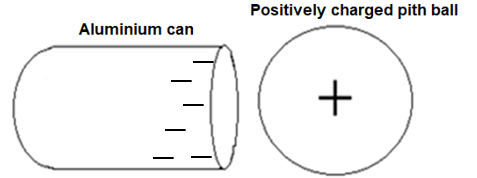
- The positively charged pith ball attracts the electrons in the metal can and, because it is a conductor, the electrons can move freely and collect at the side nearest to the pith ball.
- .
Media Attributions
- img01_Figure1 © Siyavula is licensed under a CC BY-NC-ND (Attribution NonCommercial NoDerivatives) license
- img02_Ex2.1 © DHET is licensed under a CC BY (Attribution) license
- QR_Code_PSL2SO42U2_1
- img03_Figure2 © DHET is licensed under a CC BY (Attribution) license
- img04_Figure3 © Siyavula is licensed under a CC BY-NC-ND (Attribution NonCommercial NoDerivatives) license
- img05_Figure4 © Wikimedia Commons is licensed under a CC0 (Creative Commons Zero) license
- QR_Code_PSL2SO42U2_2
- QR_Code_PSL2SO42U2_3
- img06_AssessmentQ5 © L Kleynhans is licensed under a CC BY (Attribution) license
- img07_AssessmentQ6 © L Kleynhans is licensed under a CC BY (Attribution) license
- img08_AssessmentQ © L Kleynhans is licensed under a CC BY (Attribution) license
- img09_AssessmentQ7 © L Kleynhans is licensed under a CC BY (Attribution) license
- img10_AssessmentQ7a)answer © L Kleynhans is licensed under a CC BY (Attribution) license
- Parts of the text in this unit were sourced from Siyavula Physical Science Gr 10 Learner’s Book, Chapter 16, released under a CC-BY licence ↵
the force that develops between two charged objects
a force that pushes two objects away from each other
a force that pulls two objects towards each other
materials that allow the free movement of electrons within them
substances in which the electrons are bound to individual atoms and cannot move freely
a hollow conductor, in which the charge remains on the external surface of the cage
when a charged object causes a slight redistribution of charge within a neutral object giving it a positive side and a negative side
